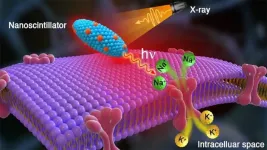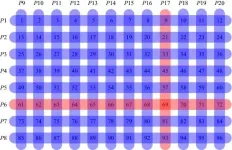(Press-News.org) Philadelphia, March 25, 2021 - Anabolic androgenic steroids (AAS), a synthetic version of the male sex hormone testosterone, are sometimes used as a medical treatment for hormone imbalance. But the vast majority of AAS is used to enhance athletic performance or build muscle because when paired with strength training. AAS use increases muscle mass and strength, and its use is known to have many side effects, ranging from acne to heart problems to increased aggression. A new study now suggests that AAS can also have deleterious effects on the brain, causing it to age prematurely.
The report appears in Biological Psychiatry: Cognitive Neuroscience and Neuroimaging, published by Elsevier.
"Anabolic steroid use has been associated with a range of medical and psychological side effects," said lead author, Astrid Bjørnebekk, PhD, Division of Mental Health and Addiction, Oslo University Hospital, Oslo, Norway. "However, since anabolic steroids have only been in the public domain for about 35 years, we are still in the early phase of appreciating the full scope of effects after prolonged use. The least studied effects are those that relate to the brain."
Steroid hormones readily enter the brain, and receptors for sex hormones are found throughout the brain. Because AAS are administered at much higher doses than those naturally found in the body, they could have a harmful impact on the brain, particularly over a long period of use. Previous studies have shown that AAS users performed worse on cognitive tests than non-users.
Dr. Bjørnebekk and colleagues performed magnetic resonance imaging (MRI) of the brains of 130 male weightlifters with a history of prolonged AAS use and of 99 weightlifters who had never used AAS. Using a set of data compiled from nearly 2,000 healthy males from age 18 to 92 years of age. The researchers used machine learning to determine the predicted brain age of each of their participants and then determined the brain age gap: the difference between each participant's chronological age and their predicted brain age. Advanced brain age is associated with impaired cognitive performance and increased risk for neurodegenerative diseases.
Not surprisingly, AAS users had a bigger brain age gap compared to non-users. Those with dependence on AAS, or with a longer history of use, showed accelerated brain aging. The researchers accounted for use of other substances and for depression in the men, which did not explain the difference between the groups.
"This important study shows in a large sample that use is associated with deviant brain aging, with a potential impact on quality of life in older age. The findings could be directly useful for health care professionals, and may potentially have preventive implications, where brain effects are also included into the risk assessment for young men wondering whether to use anabolic steroids," added Dr. Bjørnebekk.
Cameron Carter, MD, editor of Biological Psychiatry: Cognitive Neuroscience and Neuroimaging, said of the study: "The results of this brain imaging study should be of concern for athletes using anabolic steroids for performance enhancement and suggest that the adverse effects on behavior and cognition previously shown to be associated with long-term use are the result of effects on the brain in the form of accelerated brain aging."
INFORMATION:
Notes for editors
The article is "Long-term anabolic androgenic steroid use is associated with deviant brain aging," by Astrid Bjørnebekk, Tobias Kaufmann, Lisa Hauger, Sandra Klonteig, Ingunn Hullstein, Lars Westlye (https://doi.org/10.1016/j.bpsc.2021.01.001). It appears as an Article in Press in Biological Psychiatry: Cognitive Neuroscience and Neuroimaging, published by Elsevier.
Copies of this paper are available to credentialed journalists upon request; please contact Rhiannon Bugno at BPCNNI@sobp.org or +1 254 522 9700. Journalists wishing to interview the authors may contact Astrid Bjørnebekk at askrbj@ous-hf.no or +47 9414 0625.
The authors' affiliations and disclosures of financial and conflicts of interests are available in the article.
Cameron S. Carter, MD, is Professor of Psychiatry and Psychology and Director of the Center for Neuroscience at the University of California, Davis. His disclosures of financial and conflicts of interests are available here.
About Biological Psychiatry: Cognitive Neuroscience and Neuroimaging
Biological Psychiatry: Cognitive Neuroscience and Neuroimaging is an official journal of the Society of Biological Psychiatry, whose purpose is to promote excellence in scientific research and education in fields that investigate the nature, causes, mechanisms and treatments of disorders of thought, emotion, or behavior. In accord with this mission, this peer-reviewed, rapid-publication, international journal focuses on studies using the tools and constructs of cognitive neuroscience, including the full range of non-invasive neuroimaging and human extra- and intracranial physiological recording methodologies. It publishes both basic and clinical studies, including those that incorporate genetic data, pharmacological challenges, and computational modeling approaches. The 2019 Impact Factor score for Biological Psychiatry: Cognitive Neuroscience and Neuroimaging is 5.335. http://www.sobp.org/bpcnni
About Elsevier
As a global leader in information and analytics, Elsevier helps researchers and healthcare professionals advance science and improve health outcomes for the benefit of society. We do this by facilitating insights and critical decision-making for customers across the global research and health ecosystems.
In everything we publish, we uphold the highest standards of quality and integrity. We bring that same rigor to our information analytics solutions for researchers, health professionals, institutions and funders.
Elsevier employs 8,100 people worldwide. We have supported the work of our research and health partners for more than 140 years. Growing from our roots in publishing, we offer knowledge and valuable analytics that help our users make breakthroughs and drive societal progress. Digital solutions such as ScienceDirect, Scopus, SciVal, ClinicalKey and Sherpath support strategic research management, R&D performance, clinical decision support, and health education. Researchers and healthcare professionals rely on our 2,500+ digitized journals, including The Lancet and Cell, our 40,000 eBook titles; and our iconic reference works, such as Gray's Anatomy. With the Elsevier Foundation and our external Inclusion & Diversity Advisory Board, we work in partnership with diverse stakeholders to advance inclusion and diversity in science, research and healthcare in developing countries and around the world.
Elsevier is part of RELX, a global provider of information-based analytics and decision tools for professional and business customers. http://www.elsevier.com
Media contact
Rhiannon Bugno, Editorial Office
Biological Psychiatry: Cognitive Neuroscience and Neuroimaging
+1 254 522 9700
BPCNNI@sobp.org
WEST LAFAYETTE, Ind. - A Purdue University innovator has developed a new approach to creating popular thin films used for devices across a broad range of fields, including optics, acoustics and electronics.
Epitaxial lithium niobate (LNO) thin films are an attractive material for electronics and other devices. These films offer flexibility and other properties that are important to manufacturers.
The challenge is that these devices demand high-quality thin films that can be difficult to grow and produce. Haiyan Wang, a Purdue materials engineer, developed a new approach to creating these films. The work is published in Advanced Photonics Research.
"We created an approach ...
PLYMOUTH MEETING, PA [March 25, 2021] -- New recommendations to advance racial equity, ways to mitigate the impacts of the COVID-19 pandemic on cancer care, and ongoing strategies for preventing and controlling HPV-associated cancers led the conversation at the National Comprehensive Cancer Network® (NCCN®) 2021 Virtual Annual Conference March 18-20. More than 1,300 attendees from across the United States and more than 40 countries met online to learn about updates to the NCCN Clinical Practice Guidelines in Oncology (NCCN Guidelines®) and new research in the field. Sessions explored supportive care and ways to help survivors return to work, updates on best ...
For the first time, scientists have succeeded in continuous monitoring of a subglacial discharge plume, providing a deeper understanding of the glacier-fjord environment.
As marine-terminating glaciers melt, the fresh water from the glacier interacts with the seawater to form subglacial discharge plumes, or convective water flows. These turbulent plumes are known to accelerate the melting and breakup (calving) of glaciers, drive fjord-scale circulation and mixing, and create foraging hotspots for birds. Currently, the scientific understanding of the dynamics of subglacial plumes based on direct measurements is limited to isolated instances.
A team of scientists consisting of Hokkaido University's Assistant Professor Evgeny A. Podolskiy and Professor Shin Sugiyama, and the ...
URBANA, Ill. - Pumpkin growers dread the tiny tan scabs that form on their fruit, each lesion a telltale sign of bacterial spot disease. The specks don't just mar the fruit's flesh, they provide entry points for rot-inducing fungus and other pathogens that can destroy pumpkins and other cucurbits from the inside out. Either way, farmers pay the price, with marketable yields reduced by as much as 90%.
Despite the disease's severity, scientists don't know much about the genetics of the pathogen that causes it; nearly all the molecular information required for accurate diagnostic testing and targeted treatments is lacking for the disease.
In a new study, University of Illinois scientists, with the help of two undergraduate students, have assembled the first complete ...
Cambridge, MA - Astronomers have now obtained a new view of the supermassive black hole at the center of galaxy M87. Images released today by the Event Horizon Telescope (EHT) collaboration reveal how the black hole, some 55 million light-years away, appears in polarized light.
The image marks the first time astronomers have captured and mapped polarization, a sign of magnetic fields, so close to the edge of a black hole.
Scientists still don't understand how magnetic fields -- areas where magnetism affects how matter moves -- influence black hole activity. Do they help direct matter into the hungry mouths of black holes? Can ...
When clinical trials were conducted to determine the immunogenicity -- the ability to elicit an immune response -- for the first two vaccines marshaled against SARS-CoV-2the virus that causes COVID-19, one group was not among those included: people who have received solid organ transplants and others (such as those with autoimmune disorders) who are immunocompromised.
Now, Johns Hopkins Medicine researchers have tried to rectify that inequity, taking one of the first looks at how people who are immunocompromised respond to their first dose of one of the two mRNA vaccines -- Moderna and Pfizer-BioNTech -- currently being administered worldwide. Their findings, as published March 15, 2021, in a research letter in the END ...
DANVILLE, Pa. - A survey of Geisinger employees conducted over two weeks in December 2020 found a steady increase in intent among healthcare workers to receive the COVID-19 vaccine.
On Dec. 4, 2020, an announcement about anticipated vaccine availability was emailed to all 23,784 Geisinger employees. Recipients were asked to indicate their intention to receive a vaccine when one was available to them and the reasons for any hesitation they might have. More than two-thirds of employees responded to the survey.
Of those who completed the survey before Dec. 10, when an independent FDA advisory committee ...
News coverage of expert scientific evidence on vaccine safety is effective at increasing public acceptance of vaccines, but the positive effect is diminished when the expert message is juxtaposed with a personal narrative about real side effects, new research has found.
The study, by researchers affiliated with the Annenberg Public Policy Center (APPC) of the University of Pennsylvania and the University of Illinois, tested the effects of messages about vaccination in televised news reports. These included video clips of Dr. Anthony Fauci, director of the U.S. National Institute of Allergy and Infectious Diseases, talking about evidence supporting the value and safety of the MMR (measles, mumps and rubella) vaccine, and a mother who's refusing to vaccinate ...
Scientists make pivotal discovery of method for wireless modulation of neurons with X-rays that could improve the lives of patients with brain disorders. The X-ray source only requires a machine like that found in a dentist's office.
Many people worldwide suffer from movement-related brain disorders. Epilepsy accounts for more than 50 million; essential tremor, 40 million; and Parkinson's disease, 10 million.
Relief for some brain disorder sufferers may one day be on the way in the form of a new treatment invented by researchers from the U.S. Department of Energy's (DOE) Argonne National Laboratory and ...
Researchers Mario Guarracino the HSE Laboratory of Algorithms and Technologies for Networks Analysis in Nizhny Novgorod and Julius ?ilinskas and Algirdas Lančinskas from Vilnius University, have proposed a new method of testing for COVID-19. This group method allows results to be obtained 13 times faster as compared to individual testing of each sample. The research paper was published in the journal Scientific Reports.
The COVID-19 pandemic has already affected millions of people from over 200 countries. The rapid virus expansion demonstrated how fast such infections can spread in today's globalized world. At the beginning of the pandemic, when little was known about the virus and vaccines had not yet ...





